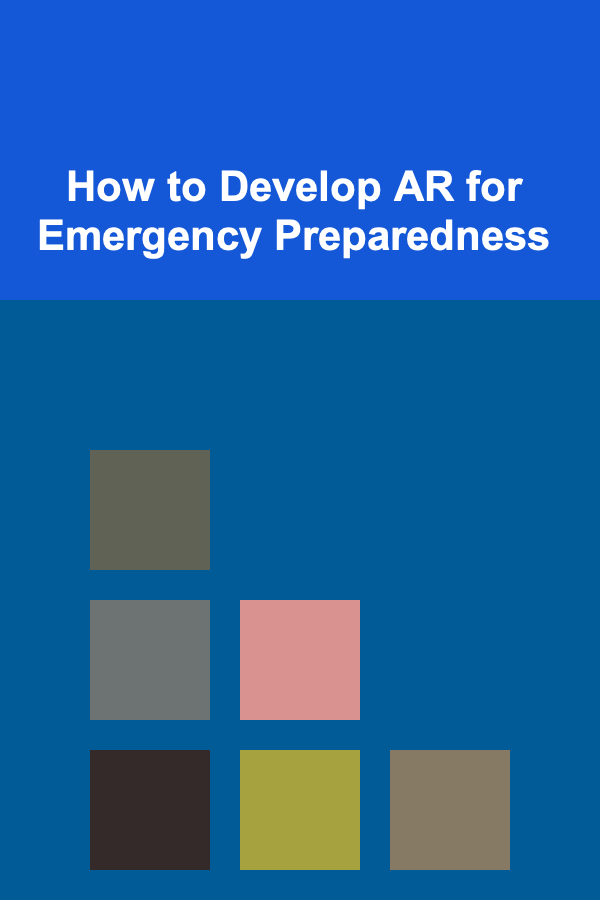
How to Develop AR for Emergency Preparedness
ebook include PDF & Audio bundle (Micro Guide)
$12.99$10.99
Limited Time Offer! Order within the next:

Augmented Reality (AR) is an emerging technology that blends the real world with digital content, offering new ways to enhance user interaction with their surroundings. In the context of emergency preparedness, AR holds significant potential to improve training, communication, and situational awareness. This article will explore how to develop AR applications for emergency preparedness, including the benefits, challenges, technical requirements, and practical applications of AR in emergency scenarios.
Understanding AR and Its Role in Emergency Preparedness
What is Augmented Reality?
AR refers to technology that overlays digital information---such as graphics, sounds, or videos---onto the physical world in real-time, enhancing the user's experience and perception. Unlike Virtual Reality (VR), which immerses users in a completely virtual environment, AR integrates digital content into the user's real-world view. This makes AR a valuable tool for applications that require interaction with both virtual and physical elements simultaneously.
Why AR for Emergency Preparedness?
In emergency situations, timely and accurate information can mean the difference between life and death. Whether it's during a natural disaster, medical emergency, or terrorist attack, first responders, emergency managers, and even civilians need access to vital information in real time. AR can provide that by offering:
- Improved situational awareness: AR can overlay crucial information, such as maps, hazards, evacuation routes, and the locations of victims or hazardous materials, directly onto a user's field of vision.
- Enhanced training capabilities: AR enables realistic simulations of emergency scenarios, allowing individuals to practice responding to disasters without the risks associated with traditional training.
- Real-time decision-making: During an emergency, AR can provide dynamic information, helping users make informed decisions quickly. For example, medical personnel can use AR to access patient data or receive step-by-step instructions during triage or treatment.
Key Steps in Developing AR for Emergency Preparedness
1. Identify Use Cases and Objectives
Before developing any AR application, it is essential to identify the specific use cases that the AR system will address. Emergency preparedness covers a wide range of situations, including natural disasters (earthquakes, floods, hurricanes), medical emergencies, and even terrorist attacks.
Some potential AR applications in emergency preparedness include:
- Disaster training simulations: Emergency responders can train for various disaster scenarios using AR, such as navigating through debris or performing search-and-rescue operations.
- On-site guidance: AR can provide first responders with real-time visual instructions or guidelines for evacuating a building or assessing a hazardous situation.
- Situational awareness for civilians: AR can guide citizens during emergencies, showing them evacuation routes, safe zones, or areas to avoid.
- Field medical assistance: For medics, AR can overlay medical protocols, medication dosages, or even visual instructions for emergency procedures.
2. Select the Right Hardware and Platforms
The choice of hardware is crucial in AR development. In emergency situations, the devices must be reliable, portable, and easy to use. Common hardware used for AR in emergency preparedness includes:
- Smartphones and Tablets: These are the most accessible AR devices, with many existing AR apps designed for smartphones. They are particularly useful for civilian applications where users might already have smartphones.
- AR Glasses: Devices like Microsoft HoloLens or Google Glass provide hands-free interaction, which can be beneficial for emergency responders who need to keep their hands free for other tasks. These devices can overlay information directly onto the user's field of vision without requiring them to look down at a screen.
- Wearable Sensors and Drones: For more advanced applications, wearable sensors or drones can be used to gather data, which is then augmented in real-time through AR. For instance, drones could scan a disaster zone, and the AR system would display relevant data such as temperature, chemical hazards, or real-time maps.
Choosing the right platform also involves deciding whether to develop for specific AR hardware (like HoloLens or smart glasses) or to create a more general mobile app that works on various devices.
3. Develop the AR Content
The core of any AR system is the digital content that is overlaid on the real world. For emergency preparedness, the content must be designed to meet specific needs and must be accurate and clear.
Some essential AR content in emergency preparedness includes:
- Maps and Navigation: During an emergency, having a map of the area with overlaid evacuation routes, hazardous zones, and safe locations can be invaluable.
- Hazardous Materials Information: AR can display real-time information about hazardous materials in the area, helping responders avoid dangerous zones.
- Emergency Protocols: For medical emergencies, AR can display life-saving procedures, medication instructions, or injury treatment protocols.
- Simulated Environments: For training, AR can create realistic simulations that allow users to experience and react to emergency situations in a controlled environment.
The content must also be dynamic, adapting to real-time data to ensure that users receive the most accurate and up-to-date information during an emergency.
4. Ensure Real-time Data Integration
One of the most critical aspects of AR in emergency preparedness is the integration of real-time data. In an emergency, conditions change rapidly, and the AR system must reflect those changes in real-time.
Some types of data that can be integrated into an AR system include:
- Geospatial Data: This includes the real-time positioning of responders, victims, and hazards. GIS (Geographic Information Systems) data is essential for mapping out areas of interest and providing navigation instructions.
- Sensor Data: In the case of environmental hazards, AR can display data from various sensors, such as temperature sensors, gas detectors, or radiation sensors. This data can help identify areas with elevated risks.
- Communication Networks: During an emergency, communication between responders and command centers is vital. AR can integrate with communication systems to provide real-time updates, warnings, and alerts directly to the user's field of view.
Ensuring seamless data integration will help guarantee that the AR system provides accurate and actionable information in real-time, which is crucial during high-pressure situations.
5. Focus on User Experience (UX) and Usability
When developing AR for emergency preparedness, user experience is paramount. The technology must be easy to use and intuitive, even in high-stress situations. To achieve this:
- Simple Interface: The AR interface should be minimalistic, with clear instructions and information that does not overwhelm the user. Information should be presented in digestible chunks, focusing on what's essential during the emergency.
- Hands-free Interaction: For first responders, hands-free operation through voice commands or gesture controls can allow them to interact with the AR system without stopping their tasks.
- Quick Response Time: In emergency scenarios, delays can be disastrous. The AR system should react quickly to changes in the environment and present data instantly.
- Durability and Reliability: The AR system must function under the challenging conditions of an emergency. Devices should be rugged, waterproof, and capable of operating in environments with unstable internet connections or power supplies.
6. Test and Validate the AR System
Before deploying AR applications for emergency preparedness, it is essential to test and validate them thoroughly. This can involve:
- User Testing: Conducting usability testing with first responders, emergency personnel, and civilians to ensure that the application is effective and user-friendly in real-world conditions.
- Simulated Scenarios: Running test simulations that mimic real emergencies will help identify potential issues, bugs, or limitations in the system.
- Continuous Improvement: After deployment, gather feedback from users and make ongoing improvements to ensure the AR system remains effective and relevant.
7. Deployment and Training
Once the AR system is developed, it needs to be deployed in a way that ensures it will be used correctly during an emergency. Training is key to ensuring that users---whether first responders or civilians---are familiar with the system and know how to use it effectively.
For emergency responders, in particular, the system should be integrated into their daily operations and training routines. Regular practice with AR during drills and training exercises can help them become more comfortable with the technology, improving their response during real emergencies.
Challenges and Considerations
While AR offers significant potential for emergency preparedness, it also comes with challenges that developers must address:
- Cost and Accessibility: AR technology can be expensive, especially when specialized hardware (like AR glasses) is required. Ensuring that emergency services and individuals can access affordable AR solutions is important.
- Battery Life and Power Supply: Emergency situations often occur in environments where power is unreliable. AR systems that rely on smartphones or tablets must be designed with power conservation in mind.
- Network Connectivity: Many AR applications depend on a stable internet connection for real-time data. In emergency scenarios, network infrastructure may be damaged, and offline functionality must be considered.
- Privacy and Security: During an emergency, data security is crucial. AR systems may need to handle sensitive information (such as medical data or law enforcement data), and developers must ensure that the system is secure from breaches.
Conclusion
Developing AR applications for emergency preparedness holds immense potential to improve the efficiency and effectiveness of emergency response efforts. By providing real-time, context-sensitive information, AR can help emergency responders and civilians make better decisions, save lives, and navigate complex situations more effectively. However, it requires careful planning, testing, and integration with real-time data systems to ensure success. As AR technology continues to evolve, it will undoubtedly play an increasingly important role in shaping the future of emergency preparedness.
Reading More From Our Other Websites
- [Organization Tip 101] Step-by-Step Guide to Installing Luxury Vinyl Plank Flooring
- [Home Storage Solution 101] How to Install and Optimize Kitchen Cabinet Organizers
- [Personal Care Tips 101] How to Choose the Best Facial Scrub for Dry Skin
- [Beachcombing Tip 101] Beachcombing Basics: What You Need to Bring for a Successful Hunt
- [Trail Running Tip 101] High-Altitude Horizons: Preparing for Trail Runs in Mountainous Terrain
- [Home Cleaning 101] How to Clean a Kitchen: A Guide to a Spotless and Organized Space
- [Home Rental Property 101] How to Make Long-Term Rentals More Appealing: Strategies for Landlords
- [Gardening 101] Low‑Maintenance Butterfly Garden Plants for Small Spaces
- [Home Storage Solution 101] How to Maximize Bathroom Storage in a Small Space
- [Paragliding Tip 101] Best Paragliding Apps That Offer Real‑Time Airtime Tracking and Flight Analytics

How to Declutter Your Home and Maintain a Minimalist Lifestyle
Read More
How to Reduce Monthly Home Expenses by Downsizing
Read More
Why Organizing Your Kitchen Drawers Can Save You Time Cooking
Read More
How To Create a Winning Content Marketing Strategy
Read More
10 Tips for Planning a Cross-Country Road Trip
Read More
10 Tips for Budget-Friendly Meal Planning
Read MoreOther Products

How to Declutter Your Home and Maintain a Minimalist Lifestyle
Read More
How to Reduce Monthly Home Expenses by Downsizing
Read More
Why Organizing Your Kitchen Drawers Can Save You Time Cooking
Read More
How To Create a Winning Content Marketing Strategy
Read More
10 Tips for Planning a Cross-Country Road Trip
Read More